Getting a tā moko is sometimes considered a coming of age. But when exactly is the right time to get one?
Tā moko connects the wearer to their lineage and culture and are typically worn by Māori.
Non-Māori wear a kiri tuhi, a tattoo that does not have the cultural aspects a moko has.
In the fourth episode of 2000s Baby, Rāwhiti and his twin brother Ivan are planning their joint 21st.
In the lead up to their birthday, Rāwhiti gets a tā moko and says it’s scary to think he might not be treated the same anymore because of it.
Re: spoke to Tāmaki-based artist Mokonuiarangi Smith.
Mokonuiarangi is skilled in the traditional artform of uhi tapu - the sacred chiselling of markings on the skin using traditional tools.
The 35-year-old from Ngāti Rangiwewehi, Te Roro o te Rangi, Te Aitanga a Māhaki and Rongowhakaata talks about the meanings behind tā moko, when is the right time to get one and how the artform has evolved over time.
Note: This interview was done in te reo Māori with translations below.
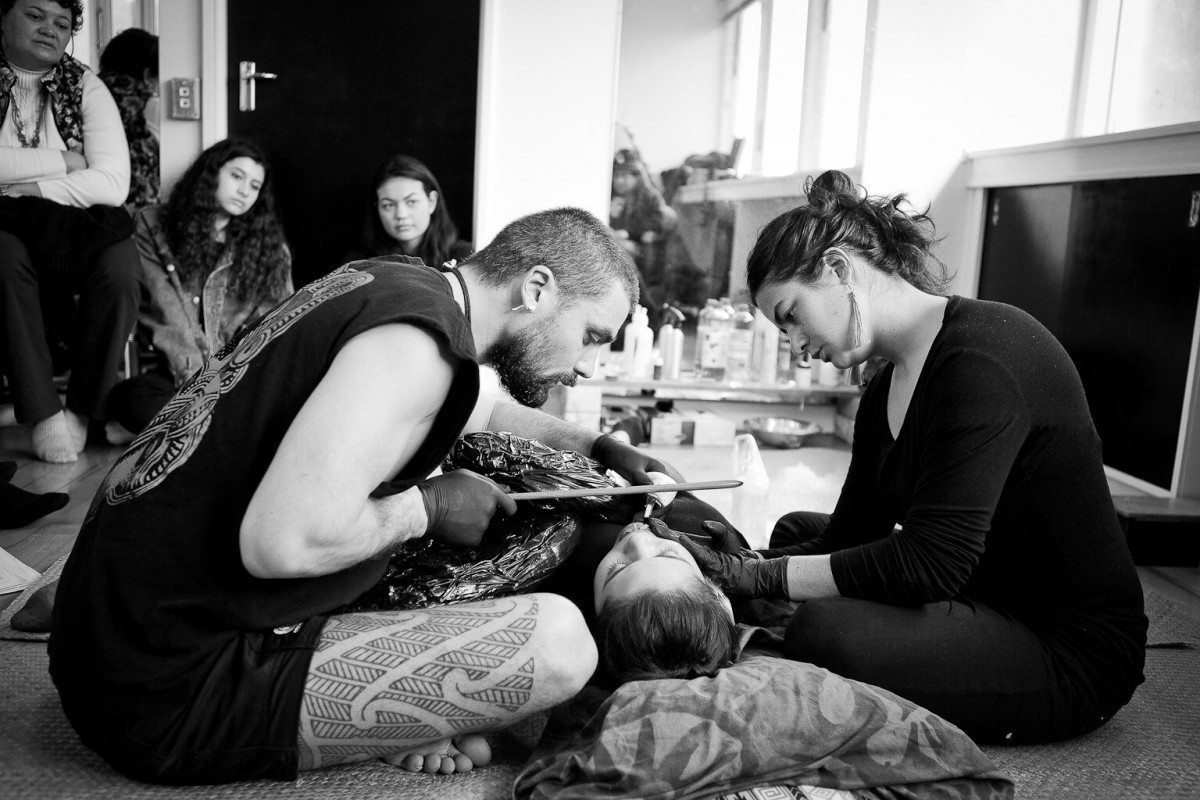
Uhi tapu artist Mokonuarangi Smith in action. Photo: Vanessa Green
He aha te take nui ka tāngia te hunga ki te moko? Āhea hoki te wā e tika ana kia tāngia ki te moko?
Why do people decide to get a tā moko and when is the right time to get one?
He nui tonu ngā kaupapa. He rerekē pea ngā momo kaupapa tā ia reanga, engari ki Tāmaki nei, kua maha tonu te hunga kua timata ki te ako i te reo kua oho mai taua hiahia kia toro atu ki te ao Māori. Ana ko te tā moko hoki he hoa pai mō taua haerenga.
Tua atu i tērā ko te hunga e whakanui ana i tō rātou whānau tērā pea kua whānau mai tētehi, tērā pea kua mate atu tētehi, ētehi he mea whakanui i ōna tapuwae, i whakatohu i ngā tapuwae, nga taumata kua piki e ia.
Nā ko te painga, i roto i ngā tau e rua, e toru kua taha ake nei, kua maha ake te hunga Māori, me ngā kaupapa Māori. I mua tonu i tēnā kua nui ake ngā turuhi me kī, ngā tāngata nō tāwahi e hiahia ana te rongo i te ngau o te uhi, otirā rātou e hiahia ana ki te whakanui i tō rātou nohonga i konei.
There are many reasons people decide to get tā moko. It’s different for each generation but here in Tāmaki, there are many people starting their journey to learn te reo which often awakens a desire to extend their Māori worldview.
And so their tā moko becomes their confidante on that journey.
In addition, there are those people who choose to honour significant family occasions like births and deaths, or some who want to honour a particular milestone or a significant achievement in their lives.
The good thing about the last two to three years is that I have seen an increase in Māori people [getting tā moko] and more kaupapa Māori around tā moko.
Before it was mostly tourists and foreigners who would come here wanting to overcome the pain of the uhi (moko chisel) and also those who wanted to signify their time spent here in Aotearoa.
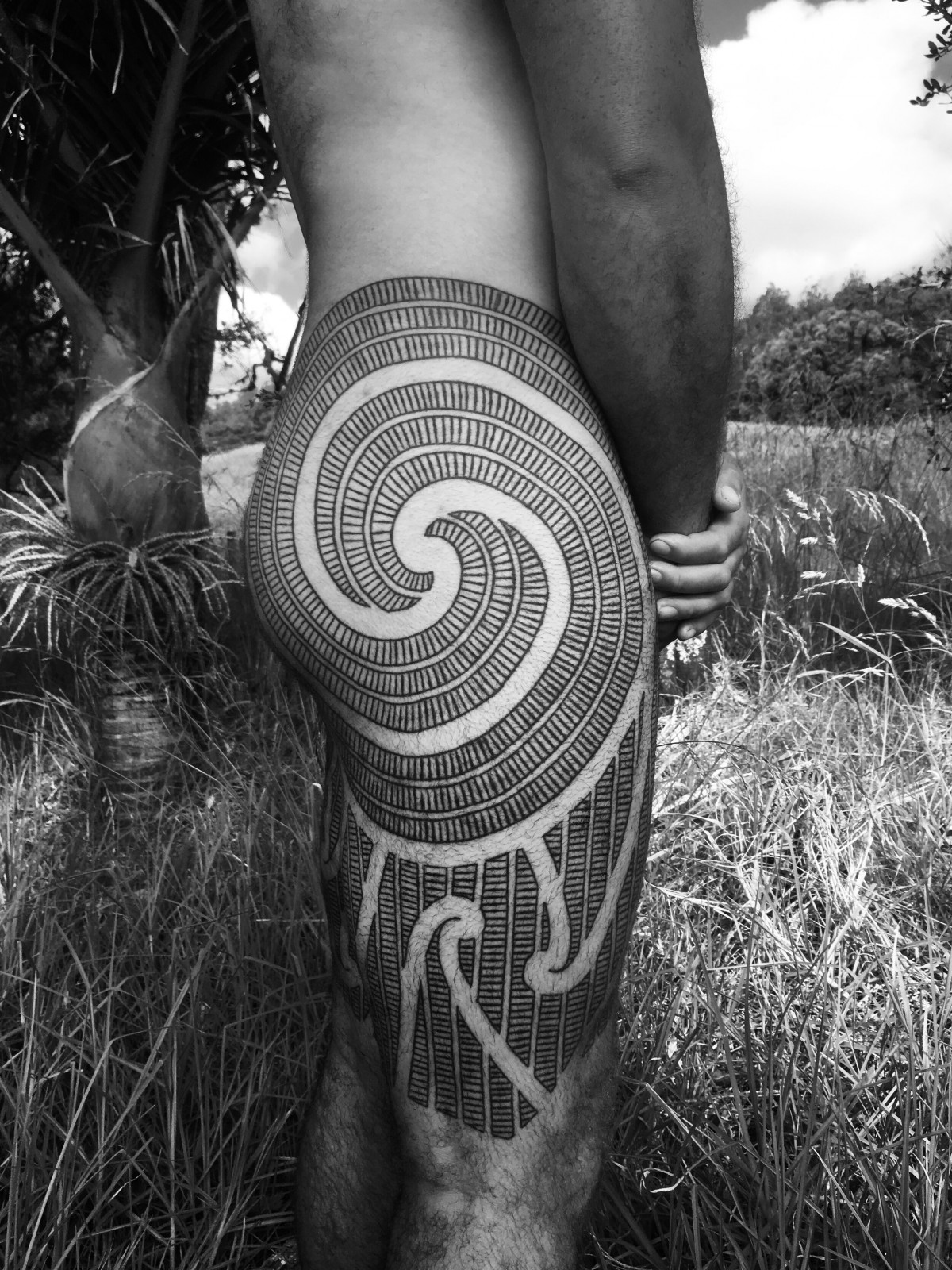
Puhoro design by Uhi tapu artist Moko Smith. Photo: Moko Smith
He aha ngā wāhi o te tīnana tuatahi e tā moko ana?
What kinds of tā moko do people typically get for their first piece?
He rerekē. Ētehi ka haere tōtika ki te puhoro, engari ko te nuinga he ringaringa, he waewae nē.
Koia rā ngā wāhi pai mō te whakamātau, mō te whakarata ki te uhi, kia mōhio pai he aha taua haerenga.
Nā tēnā kua tomo atu te tangata ki taua haerenga, ki taua ara. Mō te hunga mau kauae, ko te nuinga, me mau paku aha i mua o tena.
It’s different for everyone.
Some go straight for the puhoro (thigh design) but most people choose somewhere on the arms or legs.
Those are the good areas to trial and to ease into the uhi [which helps them] better understand what the journey ahead is like.
From there people are on that journey, on their path. People who get chin moko will rarely get any work done before this.
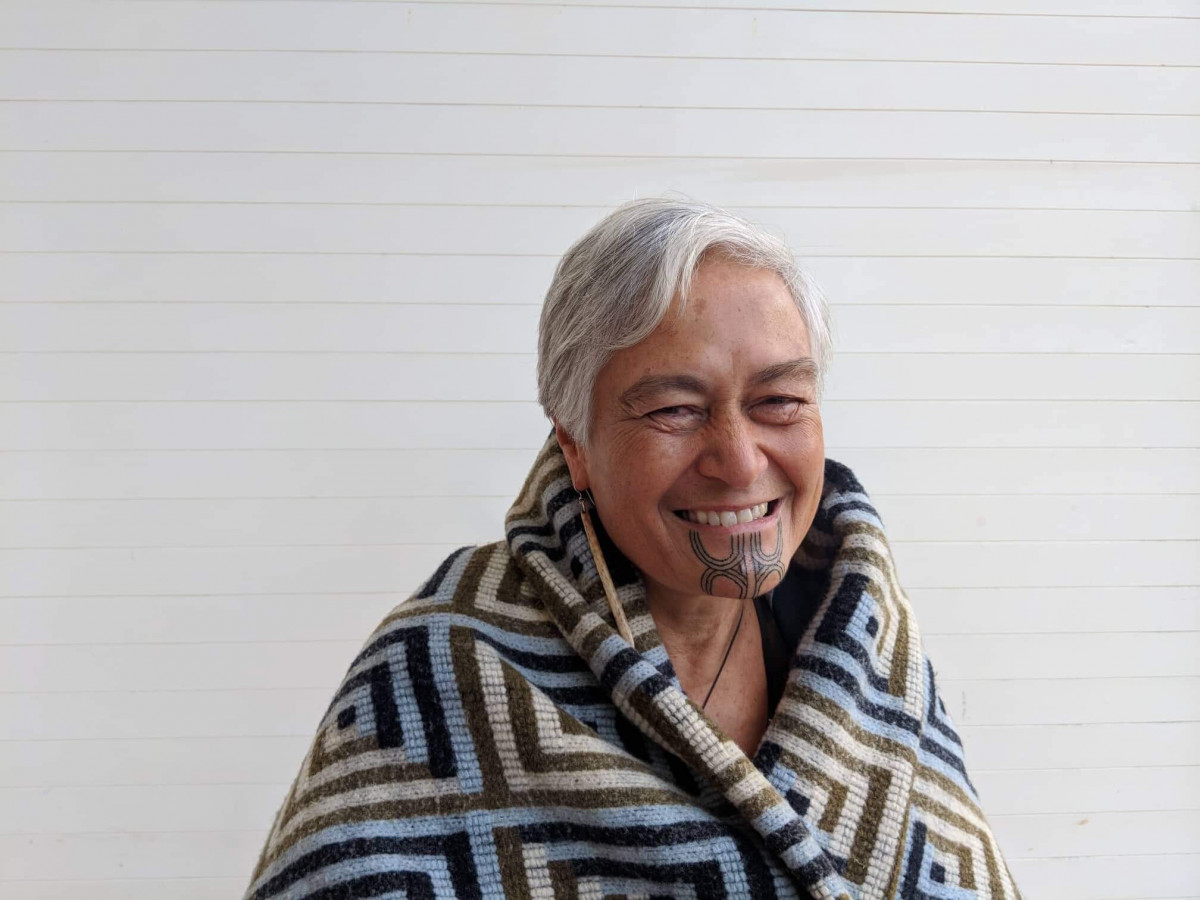
Kuia wearing moko kauae by Moko Smith. Photo: Taihuka Smith
Kua pēhea te panonitanga o te tā moko i ngā tau kua pahure?
How has the art of tā moko evolved over time?
Ko te uauatanga kua ngaro atu ngā āhuatanga o te ao tawhito. Kāore mātou e tino mōhio ana he aha te mea kua ngaro atu.
Tua atu i te haehae o te kanohi, kei te āta kite i nga whakāhua i ngā peita kua haehaetia te kanohi, taua āhuatanga kua ngaro i tēnei ao.
Ko te mea nui, i aua wā, i tono atu te whānau te hapū rānei, kia tāngia te kauae ki ngā kōtiro, kaua ki ngā pakeke, ki ngā kotiro kē. Ana ka mahia ā rōpu nei, ā tira nei, engari ka mahi ki rahaki, ka mahi ki tētehi wāhi i rāhuitia, kia kaua e kite ai te iwi.
Engari ināianei, ko te mea nui, he mahi nui, he mahi mokopapa kia hau atu te whānau katoa, te iwi katoa ki te tautoko. Kua pēnā i runga i te hiahia kia mātua kitea tēnei āhuatanga i roto i te ao Māori, kia Māori ki a tātou nei, Engari i ngā wā o mua, he mahi huna kē tēnei. Ana kei te tino mārama au he aha ai, nā te uaua o te mahi mēnā e rua rau ngā karu kei te mātaki i a koe, he mahi tino uaua tēnā.
Koia pea tētehi o ngā mea rerekē. Ka kaha mahi te hunga ki waho, ināianei ka hau atu mātou ki roto i te wharenui, ki ngā studios rānei, i mua, ka kore e pēnā. Ana, ngā wā kua tā atu au ki waho, ki runga i te whenua, ā he mīharo. Ki raro i te rākau, ka rongo i te hau, ngā hihi o te rā, he mahi tino mīharo tēnā.
He rerekē anō ngā tapu o nāianei. Wētehi kāore e aro i ngā tapu, wētehi kei te tiaki tonu i aua momo whakapono, aua momo whakaritenga, kia pai ai te hunga. Engari ko te rerekētanga nui ko ngā taputapu nē, ka tere te mahi o te mihini, he tino pukenga ōna ki te tā i te tinana, ahakoa to hiahia.
The tough thing is we’ve lost a lot of knowledge from the old days. And we don’t even know exactly what knowledge is lost.
We have face markings from pictures and paintings we have studied, reclaiming those designs.
But also, young women would be adorned with tā moko, not the adults. They would be done in groups but also it would always be done outside away from the village so the iwi do not see until it is done.
Now it’s different.
Whānau prefer larger group settings where all the family can be involved to learn and also give support. It’s like that because people want to see these aspects of te ao Māori thrive and so that’s what being Māori is to us now.
But in the old days, it was done in private. And honestly, I can understand the reason why. It’s an even more difficult task when you have 200 eyes watching you work - it’s so hard.
So one of the key differences is the work happening outside. Now people work inside the wharenui (meeting house) or inside studios. It was never like that for our ancestors.
The times I have worked outside, on the land, have been amazing. Being under the trees and feeling the wind and the sun's rays, it’s really amazing to work like that.
And of course the tools we use have evolved.
Some artists use modern tools. Others, like myself, keep true to our traditional ways of working to ensure it lives on.
Tattoo guns make the process very quick but it still takes an expert to mark the skin, no matter if you use the machine.
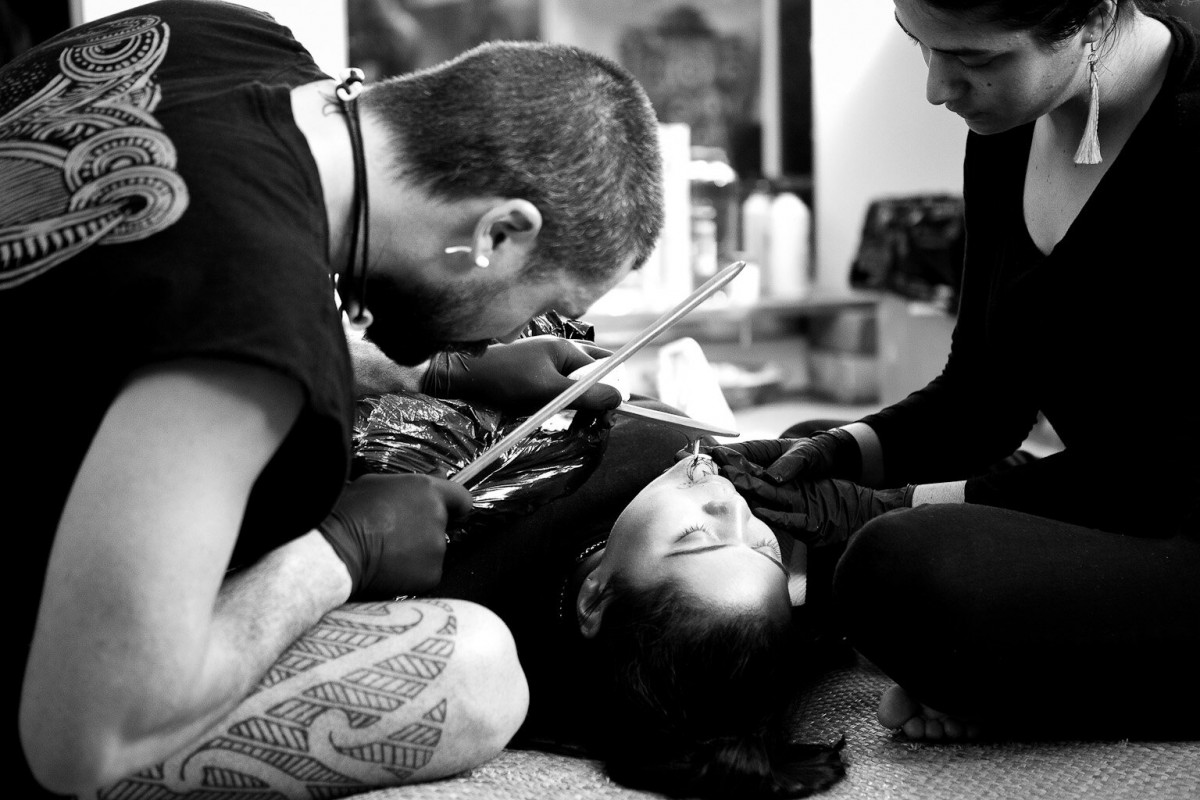
Uhi tapu artist Mokonuarangi Smith in action. Photo: Vanessa Green
He aha te māoritanga o te tā moko?
What do tā moko represent?
Tuatahi, he mahi puru korero ki te kiri o te tangata. Tuarua, ae ka taea te kī ko aua kōrero he mea e hāngai ana ki te whakapapa, engari he nui tonu ōna take.
Ētehi wā ko te whakapapa, ētehi wā ko ngā pūkenga, ētehi wā ko ngā kōrero ā whānau, ētehi wā he kōrero whenua, ētehi wā e hāngai ana ki ngā pūrākau.
Koia te take pea o ngā tohu, engari ngā take o te mau, kei te mau nei te ao Māori i ēnei tohu hei whakanui i tōna ao Māori, pūrakau mai, iwi mai, tohu whenua mai, aha rānei.
Koia ngā kaupapa o te rangi nei, te whakarauora, he kaupapa rerekē tēnā ki ngā kaupapa o te ao tawhito.
Ki tā rātou pea he tohutohu ko wai koe, ināianei kei te pēnā, engari hoki kei te whakarauora i tēnei taonga te moko.
Engari me tāpiri atu hoki tēnei mea te ‘initiate’, he momo whakakuhu i te taiohi ki ngā āhuatanga o te ao o te pakeke.
Koia tētehi mahi tawhito kei te āta whakārohia au i tēnei wā, nā te mea te taiohi, ka raru mehemea kāore tōna ara ki te rongo, kua tahi atu ia ki tētehi kaupapa nui ake i a ia. Kua hoki ia ki roto i tētehi rōpu nui ake i a ia.
Ko ia te mahi o te rangatahi nē, ka pana atu i ngā mātua kia piri atu ki tētehi rōpu, mā te moko hoki ka pēnā, ka whakahono i te taiohi ki tōna reanga, ka whakarangatira i a rātou, ka motu hoki i tērā o ngā wairua o te tamaiti e noho ana ki raro i te āhuru o te whānau, o ngā mātua.
Tērā tētahi kaupapa nui ka kitea, inā haere mai tētehi kua huri ki te rua tekau mā tahi tau, te tekau mā waru tau rānei, koia pea te kaupapa he momo pakeketeanga.
Ko tētehi o ngā tino hua o te moko, ka tahuri te whakāro ki roto, nā te mamae ka ruku koe ki roto i a koe. Mōku nei he wānanga nui tēnā me kī ake, nā ngā āhuatanga o te ao o nāianei, kua nui ake te take o taua momo wānanga, ngā wānaga o roto. Koia rā tētehi o ngā tino hua o te moko kāore e kaha kōrerotia ana.
Firstly, it’s a way of putting a story on people’s skin. Secondly, yes we’re able to say that the narrative of our genealogy is also represented but there are many different origins.
Sometimes it’s family genealogy, sometimes it represents a person's skill or expertise, and other times it’s family history, stories of the land or traditional stories.
That’s maybe what the symbols represent but the meaning of wearing them is for Māori to hold on to these ways of honouring who we are as Māori, through our stories, our tribes, our landmarks, and so forth.
The survival of the culture is the reason we practice it today, it’s a different reason from that of our ancestors.
To them maybe, it was just to identify who you were, now there are still aspects of that, but also it is about the survival of this treasure, moko.
In addition, tā moko can be worn to ‘initiate’ young people, or prepare them for adulthood.
This is a tradition I have been thinking a lot about lately as young people often face roadblocks on their path to adulthood and fitting in with their friend group.
That’s what rangatahi do though right? They ditch their parents for their mates and now they’re adults.
Moko are a way of emancipating young people, honouring who they are and cutting the ties of the childhood spirit.
That’s one big reason I see people come in, some turning 21-years-old, some turning 18- years-old, maybe to signify that coming of age.
One of the great things about moko is you delve within.
Through the pain you dive within yourself.
To me, there is a great deal of learning, especially in this world where so many [people] are worried about what’s happening on the outside. That is one of the biggest outcomes of moko that is hardly ever spoken about.
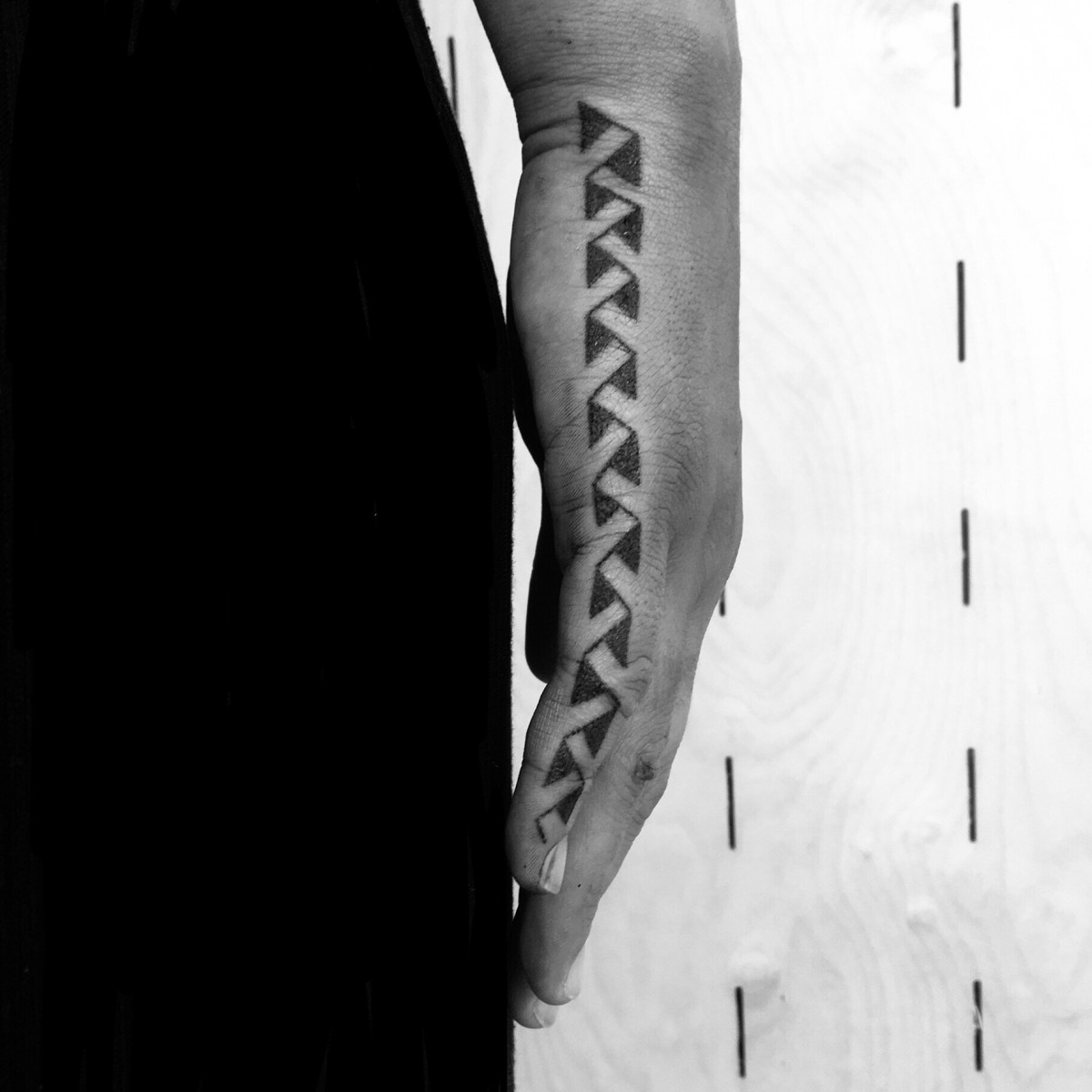
Tā moko design on hand by Uhi tapu artist Moko Smith. Photo: Moko Smith
More stories:
How to compliment someone's outfit in Sāmoan, reconnecting with roots
"The survival of the language and culture is in our day-to-day living."
Self-harm hospitalisations have doubled for 10-14-year-olds
"During the pandemic we’ve been completely online and that takes a huge toll on teenagers."
Petition to change NZ to Aotearoa presented to Parliament
Te Pāti Māori has presented its petition urging Parliament to change New Zealand's official name.